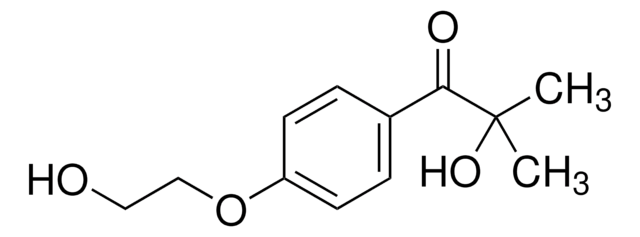729094
Poly(ethylene glycol) diacrylate
average Mn 10,000, acrylate, MEHQ as inhibitor (may contain)
Synonym(s):
Polyethylene glycol, PEG diacrylate
About This Item
Recommended Products
product name
Poly(ethylene glycol) diacrylate, average Mn 10,000, contains MEHQ as inhibitor
form
solid
Quality Level
mol wt
average Mn 10,000
contains
MEHQ as inhibitor
≤1,500 ppm MEHQ as inhibitor (may contain)
reaction suitability
reagent type: cross-linking reagent
reaction type: Polymerization Reactions
transition temp
Tm 60-64 °C
Mw/Mn
<1.1
Ω-end
acrylate
α-end
acrylate
polymer architecture
shape: linear
functionality: homobifunctional
storage temp.
−20°C
SMILES string
OCCO.OC(=O)C=C
InChI
1S/C8H10O4/c1-3-7(9)11-5-6-12-8(10)4-2/h3-4H,1-2,5-6H2
InChI key
KUDUQBURMYMBIJ-UHFFFAOYSA-N
Looking for similar products? Visit Product Comparison Guide
Related Categories
Application
- 3D Bioprinting of Hydrogels: This study explores the formulation of PEGDA-based hydrogels for 3D bioprinting, focusing on rheological properties and structural fidelity, particularly relevant for tissue engineering applications (Wu et al., 2018).
- Sustained Ocular Drug Delivery: Investigates the delivery of small and large drug molecules using PEGDA implants, highlighting the implications for sustained drug release in ocular therapies (McAvoy et al., 2018).
- Tissue Engineering Scaffolds: Evaluates PEGDA-polycaprolactone scaffolds for tissue engineering, emphasizing the control over porosity and its importance for regenerative medicine applications (Kotturi et al., 2017).
- Photocrosslinked Hydrogel Implants: Focuses on photocrosslinked PEGDA implants for drug delivery, providing insights into the design of drug delivery systems that can be finely tuned for specific therapeutic needs (Qin et al., 2015).
- Hydrogel-Based Artificial Muscles: Characterizes PEGDA/acrylic acid hydrogels optimized for use as artificial muscles, highlighting their potential in biomedical engineering and smart materials (Browe et al., 2017).
Preparation Note
Signal Word
Danger
Hazard Statements
Precautionary Statements
Hazard Classifications
Eye Dam. 1 - Skin Irrit. 2 - Skin Sens. 1
Storage Class Code
11 - Combustible Solids
WGK
WGK 1
Flash Point(F)
Not applicable
Flash Point(C)
Not applicable
Choose from one of the most recent versions:
Already Own This Product?
Find documentation for the products that you have recently purchased in the Document Library.
Customers Also Viewed
Articles
Devising biomaterial scaffolds that are capable of recapitulating critical aspects of the complex extracellular nature of living tissues in a threedimensional (3D) fashion is a challenging requirement in the field of tissue engineering and regenerative medicine.
Our team of scientists has experience in all areas of research including Life Science, Material Science, Chemical Synthesis, Chromatography, Analytical and many others.
Contact Technical Service









